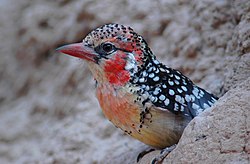| Trachyphonus | |
|---|---|
 | |
| Red-and-yellow barbet Trachyphonus erythrocephalus | |
| Scientific classification | |
| Kingdom: | Animalia |
| Phylum: | Chordata |
| Class: | Aves |
| Order: | Piciformes |
| Family: | Lybiidae |
| Subfamily: | Trachyphoninae |
| Genus: | Trachyphonus Ranzani, 1821 |
| Type species | |
| Trachyphonus vaillantii Ranzani, 1821 [1] | |
The African terrestrial barbets are the bird genus Trachyphonus in the African barbet family (Lybiidae), which was formerly included in the Capitonidae and sometimes in the Ramphastidae. These birds are more terrestrial than the other African barbets and differ in some other respects too; they are thus separated in the subfamily Trachyphoninae.












